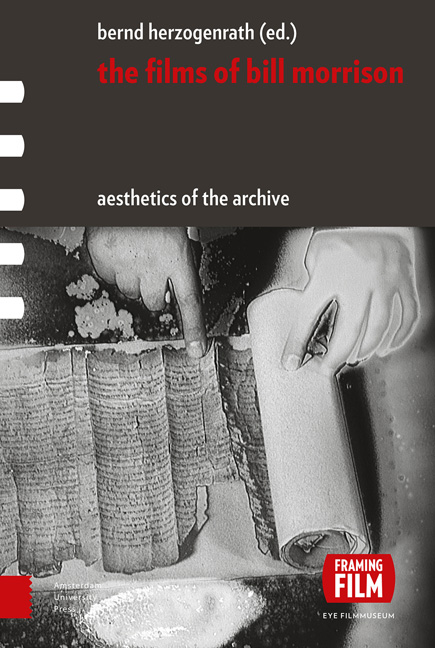Book contents
- Frontmatter
- Contents
- Acknowledgments
- Aesthetics of the Archive: An Introduction
- Chapter 1 Drafts and Fragments: Reflections around Bill Morrison and the Paper Print Collection
- Chapter 2 The Film of Her: The Cine-Poet Laureate of Orphan Films
- Chapter 3 Ghost Trip: Searching for Potential Myths
- Chapter 4 Decasia: The Matter | Image: Film is also a Thing
- Chapter 5 The Mesmerist: Illustrating the Return of the Repressed
- Chapter 6 Light is Calling: Celluloid Dreams
- Chapter 7 Gotham: Zoetrope: Block by Block
- Chapter 8 Outerborough: Early Cinema Revisited
- Chapter 9 The Highwater Trilogy: Thinking the Liquid – On the Ethics of Water and the Material Ecologies of Disaster and Ruination
- Chapter 10 Porch: Archives, Collective Memory, and the Poetics of Home Movies
- Chapter 11 The Future Lasts Long: The Romanov Lost Family Archives
- Chapter 12 Who by Water: Variations on Matter, Figures, Memory, and Mythology
- Chapter 13 Every Stop on the F-Train: Beyond and within the Restless Netherworld of (Manhattan’s) Mind
- Chapter 14 Spark of Being: Bachelor Machine
- Chapter 15 The Miners’ Hymns: Acts of Resurrection
- Chapter 16 Tributes – Pulse: A Requiem for the 20th Century: Death | Drive | Image
- Chapter 17 Just Ancient Loops: The Loops of Life in Intonation
- Chapter 18 The Great Flood: Water is Transparence Derived from the Presence of Everything
- Chapter 19 Re-Awakenings: Bill Morrison in Conversation
- Index of Film Titles
- Index of Names
- Index of Subjects
- Already Published
Chapter 7 - Gotham: Zoetrope: Block by Block
Published online by Cambridge University Press: 12 December 2020
- Frontmatter
- Contents
- Acknowledgments
- Aesthetics of the Archive: An Introduction
- Chapter 1 Drafts and Fragments: Reflections around Bill Morrison and the Paper Print Collection
- Chapter 2 The Film of Her: The Cine-Poet Laureate of Orphan Films
- Chapter 3 Ghost Trip: Searching for Potential Myths
- Chapter 4 Decasia: The Matter | Image: Film is also a Thing
- Chapter 5 The Mesmerist: Illustrating the Return of the Repressed
- Chapter 6 Light is Calling: Celluloid Dreams
- Chapter 7 Gotham: Zoetrope: Block by Block
- Chapter 8 Outerborough: Early Cinema Revisited
- Chapter 9 The Highwater Trilogy: Thinking the Liquid – On the Ethics of Water and the Material Ecologies of Disaster and Ruination
- Chapter 10 Porch: Archives, Collective Memory, and the Poetics of Home Movies
- Chapter 11 The Future Lasts Long: The Romanov Lost Family Archives
- Chapter 12 Who by Water: Variations on Matter, Figures, Memory, and Mythology
- Chapter 13 Every Stop on the F-Train: Beyond and within the Restless Netherworld of (Manhattan’s) Mind
- Chapter 14 Spark of Being: Bachelor Machine
- Chapter 15 The Miners’ Hymns: Acts of Resurrection
- Chapter 16 Tributes – Pulse: A Requiem for the 20th Century: Death | Drive | Image
- Chapter 17 Just Ancient Loops: The Loops of Life in Intonation
- Chapter 18 The Great Flood: Water is Transparence Derived from the Presence of Everything
- Chapter 19 Re-Awakenings: Bill Morrison in Conversation
- Index of Film Titles
- Index of Names
- Index of Subjects
- Already Published
Summary
ABSTRACT
David Gersten offers a close reading of Morrison's 2004 film Gotham and speculates on the idea of the modern city as a living zoetrope, one that combines film and architecture into a lived experience that may signal a shift in the nature of human nature.
New York City exists in a continuous state of change. At every given instant, at every given moment, the city gives voice to our transformations. In Gotham, Morrison's deep meditation on this city, these voices are made present in the sphere of life, their shadows are captured and cast into the lived space of our shared stories: the metropolis imagines itself out of the human, and the human bears, is born of, and is borne by the city.
KEYWORDS
Walter Benjamin, Louis Lumière, Elisha Otis, ghosts
There are 80 years between the construction of the Eiffel Tower (1889) and the construction of the World Trade Center Towers (1969) – one lifetime. This period is immediately preceded by the emergence of photography (Louis Daguerre, 1839) and its evolution into film (Louis Lumière, 1895). Today, we are 46 years from the construction of the World Trade Towers, and they have been gone for fifteen years, ghosts, halfway through a half-life(time).
William Burroughs, in his short book, The Four Horseman of the Apocalypse, tells a wonderful story about frogs. He describes how frogs started out living in the water with gills rather than lungs; they could not survive outside water, but some rare frogs had gills that, for short moments, could serve as lungs. In times of drought, these frogs could make short runs out onto land to search for other sources of water. Through natural selection, these frogs survived and, after many trips onto land, their gills transformed. They grew into lungs and the frogs ultimately moved onto land. So the frog, searching for water, found land.
Recently, I read a few stories about two gigantic black holes that scientists believe are about to collide in deep space. These black holes are so enormous that the explosion resulting from their collision was described as releasing an unfathomable force, one that will blow entire galaxies away, like leaves being blown off a tree during a hurricane. The two black holes are only one ‘light week’ apart from each other, making scientists believe that their collision is imminent.
- Type
- Chapter
- Information
- The Films of Bill MorrisonAesthetics of the Archive, pp. 123 - 136Publisher: Amsterdam University PressPrint publication year: 2017



